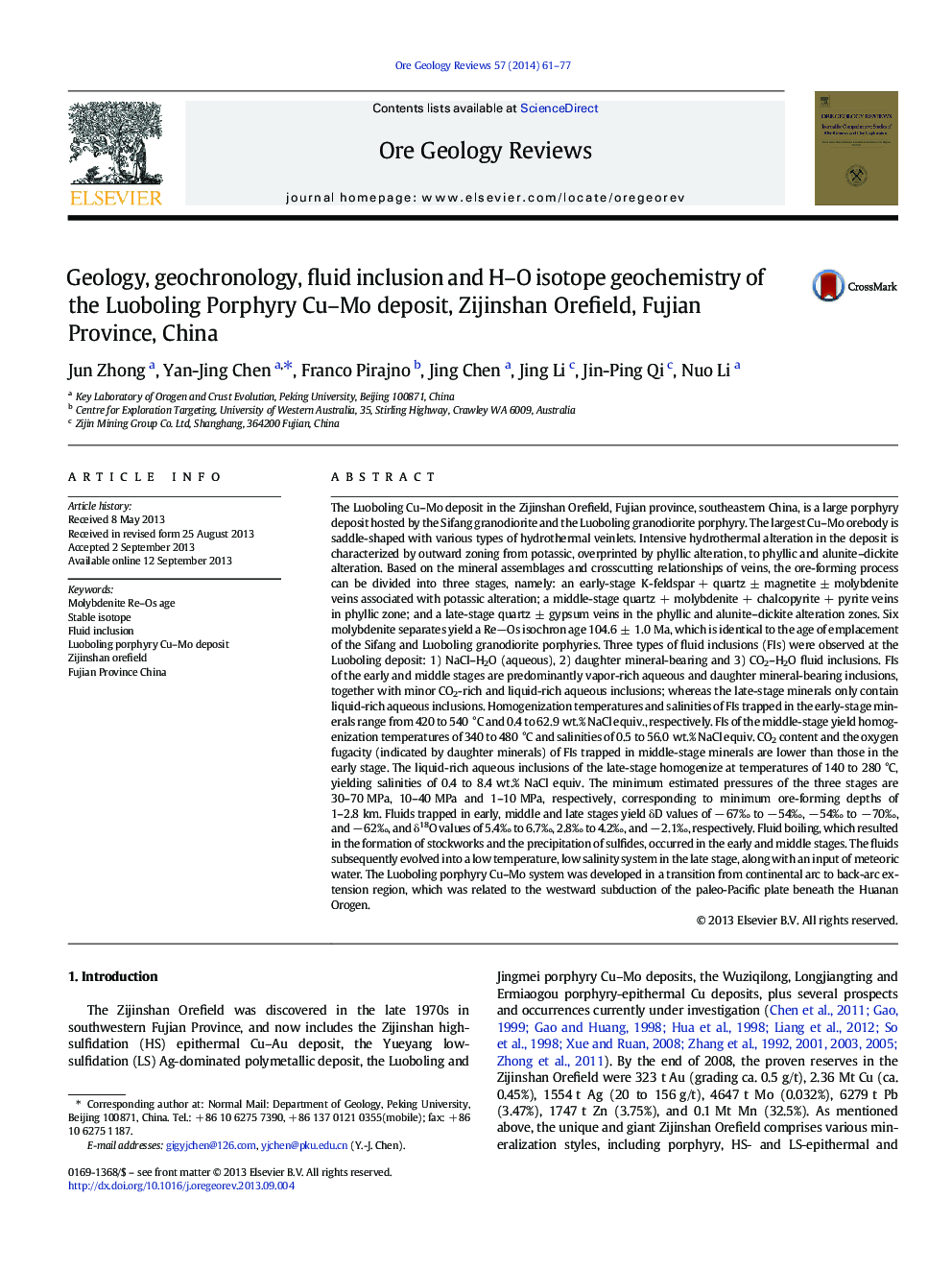| کد مقاله | کد نشریه | سال انتشار | مقاله انگلیسی | نسخه تمام متن |
|---|---|---|---|---|
| 4697495 | 1637246 | 2014 | 17 صفحه PDF | دانلود رایگان |
• The Luoboling porphyry Cu–Mo deposit, Zijinshan Orefield, occurs in Huanan Orogen.
• The deposit developed in a transition from continental arc to back-arc extension at ~ 105 Ma.
• It is shallow-seated and contains CO2-rich, daughter mineral-bearing and aqueous inclusions.
• Ore fluids evolved from hypothermal, saline and CO2-rich to epithermal, dilute, CO2-poor.
• H–O isotope signatures show the fluids evolved from magmatic to meteoric in origin.
The Luoboling Cu–Mo deposit in the Zijinshan Orefield, Fujian province, southeastern China, is a large porphyry deposit hosted by the Sifang granodiorite and the Luoboling granodiorite porphyry. The largest Cu–Mo orebody is saddle-shaped with various types of hydrothermal veinlets. Intensive hydrothermal alteration in the deposit is characterized by outward zoning from potassic, overprinted by phyllic alteration, to phyllic and alunite–dickite alteration. Based on the mineral assemblages and crosscutting relationships of veins, the ore-forming process can be divided into three stages, namely: an early-stage K-feldspar + quartz ± magnetite ± molybdenite veins associated with potassic alteration; a middle-stage quartz + molybdenite + chalcopyrite + pyrite veins in phyllic zone; and a late-stage quartz ± gypsum veins in the phyllic and alunite–dickite alteration zones. Six molybdenite separates yield a Re−Os isochron age 104.6 ± 1.0 Ma, which is identical to the age of emplacement of the Sifang and Luoboling granodiorite porphyries. Three types of fluid inclusions (FIs) were observed at the Luoboling deposit: 1) NaCl–H2O (aqueous), 2) daughter mineral-bearing and 3) CO2–H2O fluid inclusions. FIs of the early and middle stages are predominantly vapor-rich aqueous and daughter mineral-bearing inclusions, together with minor CO2-rich and liquid-rich aqueous inclusions; whereas the late-stage minerals only contain liquid-rich aqueous inclusions. Homogenization temperatures and salinities of FIs trapped in the early-stage minerals range from 420 to 540 °C and 0.4 to 62.9 wt.% NaCl equiv., respectively. FIs of the middle-stage yield homogenization temperatures of 340 to 480 °C and salinities of 0.5 to 56.0 wt.% NaCl equiv. CO2 content and the oxygen fugacity (indicated by daughter minerals) of FIs trapped in middle-stage minerals are lower than those in the early stage. The liquid-rich aqueous inclusions of the late-stage homogenize at temperatures of 140 to 280 °C, yielding salinities of 0.4 to 8.4 wt.% NaCl equiv. The minimum estimated pressures of the three stages are 30–70 MPa, 10–40 MPa and 1–10 MPa, respectively, corresponding to minimum ore-forming depths of 1–2.8 km. Fluids trapped in early, middle and late stages yield δD values of − 67‰ to − 54‰, − 54‰ to − 70‰, and − 62‰, and δ18O values of 5.4‰ to 6.7‰, 2.8‰ to 4.2‰, and − 2.1‰, respectively. Fluid boiling, which resulted in the formation of stockworks and the precipitation of sulfides, occurred in the early and middle stages. The fluids subsequently evolved into a low temperature, low salinity system in the late stage, along with an input of meteoric water. The Luoboling porphyry Cu–Mo system was developed in a transition from continental arc to back-arc extension region, which was related to the westward subduction of the paleo-Pacific plate beneath the Huanan Orogen.
Journal: Ore Geology Reviews - Volume 57, March 2014, Pages 61–77
